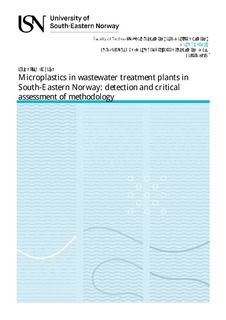| dc.description.abstract | Microplastic has gained increasing attention since it is an environmental concern and it has been found in water, soil and air. Wastewater treatment plants have been reported as pathway for microplastics to aquatic environments and soil, even though the efficiency of removal of microplastics from wastewater treatment plants has been shown to be high in some studies. This study aims to investigate the presence of microplastics in four wastewater treatment plants in Norway (both in wastewater and sludge samples) and also to do a critical assessment of the methodology used. The results showed that fibers/filaments was the most common category. In overall, microplastic particles from wastewater samples consisted of fibers/filaments (71.5%), fragments (8.9%), other shapes (8.9%) and beads (6.8%). For the sludge samples, Fibers/filaments consisted 66.2%, fragments 30.9%, other shapes 1.8% and beads 1.2%. Black fibers were the most common. The mean of total microplastic particles calculated for the facilities varied from 289 to 829 (MP/L) in the influent samples. In the effluent samples, it varied from 144 to 746 MP/L. In sludge samples, the mean of total microplastic particles for the treatment plants varied from 13770 to 37502 MP/Kg (d.w). However, these results should be analysed with caution since the samples were not subjected to chemical analysis, only visual identification. It is possible that the presence of non-plastic particles resulted in an overestimation; or underestimation due to barely visible particles and the difficult identification of so small particles. There was a significant difference between the total numbers of microplastic particles found for some facilities. However, more studies should be done to understand why this difference exist, since many factors are involved. There was no significant difference between months and total microplastic particles found. No significant correlation was found between population equivalent and total microplastic particles in the influent samples. Regarding methodology, many topics were discussed from the extraction to identification in order to contribute with information to develop a standardized methodology in future studies. | nb_NO |
